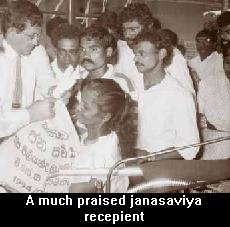9th July 2000
Politics of the Samurdhi
Front Page|
News/Comment|
Plus| Business| Sports|
Sports Plus| Mirror Magazine

![]()
 On
the eve of a par liamentary general election the government has brought
down the price of flour by three rupees and has increased the pensions
by Rs. 300 and the salaries of government servants by Rs. 600 still more
significant from a political point of view is the increase of the allowance
paid to Samurdhi recipients by Rs. 200 and the allowances of less than
Rs. 250 per month by Rs. 150.
On
the eve of a par liamentary general election the government has brought
down the price of flour by three rupees and has increased the pensions
by Rs. 300 and the salaries of government servants by Rs. 600 still more
significant from a political point of view is the increase of the allowance
paid to Samurdhi recipients by Rs. 200 and the allowances of less than
Rs. 250 per month by Rs. 150.
The political benefits to be reaped from paying very generous charities from public funds to people at the very bottom of poverty, without helping them to get out of poverty, but keeping them in abject poverty are very great.
Although there was an element of political deception also in the Janasaviya programme created by President Premadasa who may be considered to be the only leader who came from the ordinary class, that programme had the possibility too, of taking the people who were at the bottom of poverty out of it.
The monthly allowance paid from the Janasaviya to a family receiving Janasaviya was Rs. 1250. While a sum of Rs. 250 had to be saved compulsorily, it was also compulsory to work for a specific number of days at a programme aimed at providing rural common amenities for the allowance received. Therefore it was not a charity. People repaid with their labour for the allowances they received from public funds.
At the same time a large number of additional programmes were also implemented for their upliftment. Those people were given priority in the low income housing projects. They were given priority in the employment opportunities in the garments industry too.
The PA government wanted to increase to a very great extent the number of those who would vote for it on the basis of poverty and relief granted by means of a massive increase in the number of those who receive allowances, while keeping the expenditure at the same level as that of Janasaviya. The Samurdhi programme was created for that purpose.
While the number of the families who were included in the Janasaviya was 500,000, the number of families included in the Samurdhi programme was 1,973,183 while 1% of that number, namely 19,737 get an allowance of Rs. 1,000 per month, 45% or 887,932 families get Rs. 500- per family per month. 323,710 families receive Rs. 200- per family per month while 216,445 families receive Rs. 100- per family per month. 521,886 families who had got Janasaviya are now paid a sum of Rs. 250- per family.
Of the allowance paid to the Samurdhi receipients, a sum of Rs. 25 per month is deducted for insurance.
The Samurdhi social security fund which may be called the ministers political fund has been built with the insurance money thus obtained. In addition, those who get an allowance of Rs. 1,000/- per month must save Rs. 200/- and those who get Rs. 500/- must save Rs. 100/- compulsory. At present there is a sum of more than Rs. 5000 million in the compulsory savings fund alone. It is with those funds that action is being taken, against the accepted financial regulations of the government, to purchase a private-bank.
There was politics not only in the Samurdhi programme but also in the Janasaviya Programme. It may be that President Pramadasa too asked the Jana-saviya receipients to vote for his party. However, there was no strict rule that the Janasaviya recipients should compulsorily vote for him.
But the politics of the Samurdhi is different. It does not get work done in labour or otherwise for the allowance paid, as was done in the case of Janasaviya. In that sense the Chandrika government is more compassionate to the poor than was the Premadasa government.
The only compulsion allegedlymade to the poor who received the Samurdhi is that they should vote for the Chandrika government. In order to ensure that every such vote is cast for the PA a special method is allegedly used.
This method allegedly was implemented at every provincial council election. It was allegedly implemented in a quite organized manner at the last presidential election too. Under the minister's signature a circular was sent to Samurdhi managers requesting them to classify the Samurdhi recipients coming under them according to their loyalty, with the help of the Samurdhi animators. At the presidential election the minister sent a secret letter under his signature to all MPs and organizers of electorates asking them not to involve Samurdhi animators in other work because he had entrusted the Samurdhi animators of every electoral division with a special job. The credit for the victory at the presidential election also went to the Samurdhi minister.
After the victory at the presidential election, the Samurdhi director-general along with the district chiefs of Samurdhi, who may be considered the leading members of the minister's electoral machine, was allegedly sent to Thailand on a trip with the cost being met from the Samurdhi social security fund.
The political aim of increasing at this time the allowance paid to the Samurdhi recipients may be to create the atmosphere necessary to carry out the programmes implemented in all the electorates , with greater confidence.








![]()
Front Page| News/Comment| Editorial/Opinion| Plus| Business| Sports| Sports Plus| Mirror Magazine
Please send your comments and suggestions on this web site to


